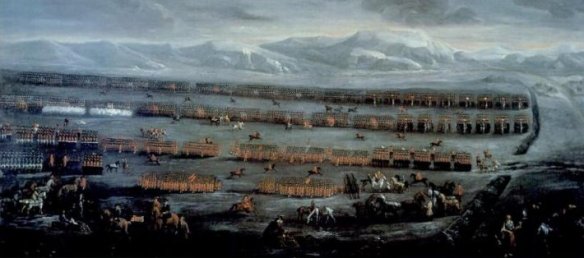Battle of Sheriffmuir
PRINCIPAL COMBATANTS: Jacobites (supporters of James Edward, the Old Pretender) vs. British supporters of King George I
PRINCIPAL THEATER(S): Scotland and northern England
DECLARATION: None
MAJOR ISSUES AND OBJECTIVES: Dissatisfied with Hanoverian rule in Britain and the Union of England and Scotland, the Jacobites rallied to the cause of James Edward, the Old Pretender, seeking his elevation to the English throne as James III.
OUTCOME: The rebellion was crushed, its leaders executed or exiled.
APPROXIMATE MAXIMUM NUMBER OF MEN UNDER ARMS: Combined Scots and English Jacobite force, 12,000; government forces were larger
CASUALTIES: At Preston, rebels, 42; loyalists, 276. At Sheriffmuir, rebels, 150; loyalists 490. Overall estimate of fatalities, 3,000.
TREATIES: None
Popularly called “The Fifteen,” this revival of the effort to restore the Stuarts to the throne of England (began in response to the plea of James II’s (1633–1701) son James Edward (known as the “Old Pretender”; 1688–1766) for a clan uprising in Scotland a year after George I (1660–1727), the first of the House of Hanover to rule Great Britain, arrived in London. The Jacobites, who had unsuccessfully opposed the Union of Scotland and England in 1707 and then lost a vote to repeal the union in 1713, answered James Edward’s call. John Erskine (1675–1732), the earl of Mar, proclaimed James Edward James III of England and James VIII of Scotland, and denounced the union. Some 18 Scottish lords rallied behind the Pretender’s banner when it was raised by Mar, bringing with them 5,000 men. At that point government troops in Scotland numbered only about 1,500, so had Mar acted forcefully at the start of the rebellion it might have turned out differently. Instead, he marched on Perth, which his forces seized, but he did not continue on to Sterling, the next logical target. Instead he delayed as he waited for reinforcements. It was a blunder that gave the English time to rally and march north.
King George’s government was also afforded the time to concentrate on the Jacobite threat in England proper. Parliament granted the new king the right to imprison anyone he suspected of conspiring against him, and beginning in September 1715, he did so with alacrity. The first arrest was an officer in the Guards, accused of enlisting men for the Stuart cause, but soon six members of Parliament were also rounded up, including Sir William Wyndham (1687–1740), suspected of plotting a revolt in the West Country.
Another MP, Thomas Forster (c. 1675–1738), did indeed lead a rising in the north along with James Radcliffe (1689–1716), third earl of Derwentwater. Together they marched about 2,000 men south hoping to hook up with Mar but were intercepted on November 14 and defeated by the government on November 15, 1715, at the battle of Preston. Meanwhile, Mar—with some 10,000 troops—had engaged 3,500 soldiers under General John Campbell (1678–1743), second duke of Argyll, at Sheriffmuir on November 13 in an indecisive battle whose outcome was nevertheless enough, along with the defeat at Preston, to herald the collapse of the Jacobite challenge.
By the time James himself reached Scotland in December, Mar’s army had withered away even as Argyll’s was reinforced, including the arrival of a Dutch contingent. James abandoned his lost cause, leaving England never to return, and taking with him back to France the earl of Mar. “The Fifteen” collapsed, and Derwentwater, along with 29 others, was executed in 1716. Other Jacobite leaders were deported, peerages were forfeited, and clans were disarmed.
Further reading: Leo Gooch, The Desperate Faction?: The Jacobites of North-East England, 1688–1745 (Hull, England: University of Hull Press, 1995); Bruce Lenman, The Jacobite Risings in Britain, 1689–1746 (London: Scottish Cultural Press, 1995).
